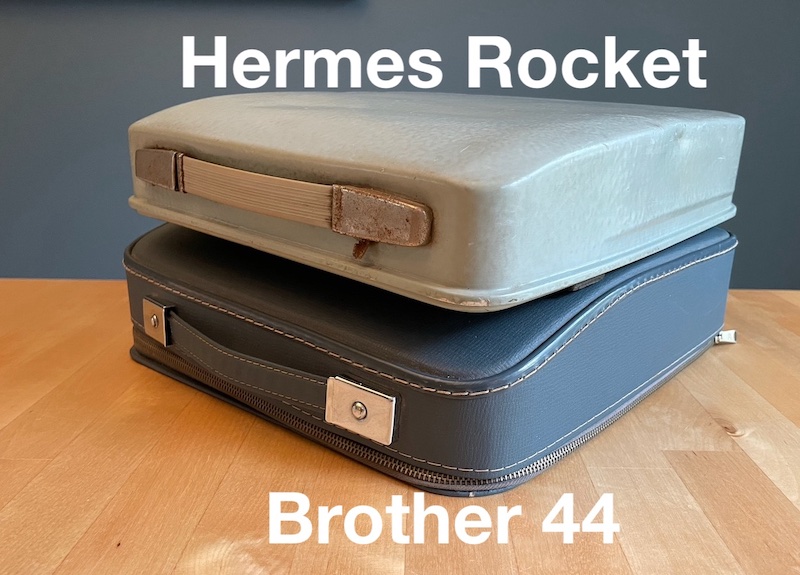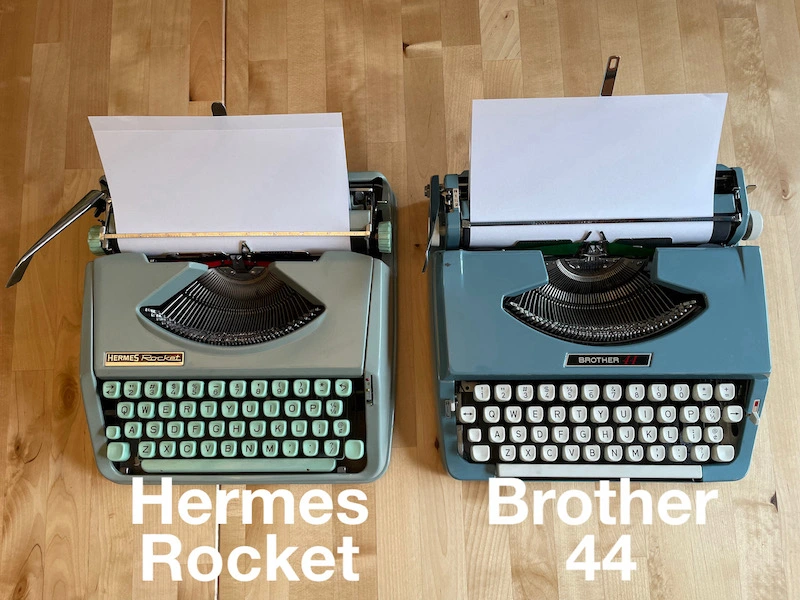When I was on the road for a couple months in my tiny camper I packed an Olivetti Lettera 32. Prior to leaving it had been my daily typer. It fills the gap between a larger portable and an ultra-portable. So naturally, I felt it was the perfect trip companion. But there was a lingering feeling that it wasn’t the perfect fit. The longer I spent in the wilds of the American Southwest, the more I wished I’d had a Hermes Rocket. It’s much smaller and its snap-on shell makes it easy to stash with all the gear. I felt a Rocket was the pinnacle of ultra-compacts. But then I hooked up with fellow One Typed Pager, Paul H., in Hemet, California and took his Brother Charger for a spin.
In all the years I’ve been writing about typewriters, I’d never come across a Brother. Never even gave them a glance. I mean, c’mon, Brother, why bother? They made electronic office equipment and came into the typewriter game late. In fact, they still make electric typewriters. A little research also revealed Brother is a Japanese company. Today, Japan makes top notch stuff, but back in the 1960s and 70s, we Americanos associated “Made in Japan” as being cheap and economical. So when Paul asked if I’d like to try his Brother Charger, I smiled politely (with a hint of snobbery) and said sure.
What he brought out blew me away. Here was this sleek blue manual typewriter with a snap-on shell. When I hefted it, its all metal body felt solid. Well made. But how would it type? Fantastic! I vowed when I got home I’d snag a Brother and write a full review. Not only did I get a Brother but also a Hermes Rocket. How about that? Two reviews in one! Betcha didn’t see that coming! I feel the Hermes Rocket is the standard by which all other ultras are judged. So why not put the Brother to the test?
So here it is Brother vs. Hermes. Japan vs. Switzerland.
To start, I didn’t get a Brother Charger, but found a Brother 44 instead. It feels similar to Paul’s Charger. Instead of the snap-on shell, it comes with a zippered case. I’m not a big fan of zippers having had bad experiences with Lettera 32 cases. But the YKK metal zipper on the Brother is tops, unlike the cheap plastic one with the Lettera. The Brother’s zippered case keeps it snug and fit. There didn’t seem to be much wiggle room inside. The handle was easy to grab and stash. It feels like a piece of high-end luggage. Even though the Brother 44 comes in a case, when stacked up against the Rocket, it’s hard to tell the difference in size.

Once it’s out of the case and on the desk, the Brother feels way more solid, fast and snappy. In fact, it feels like a much larger typewriter. There is nothing flimsy about a Brother. It’s a speedster and types with authority. No matter how fast I typed — and I can fly — it kept up. If you’re a quick thinker page drafter who doesn’t like to dawdle, these Brothers rival the best portables. And when you’re striking the carriage return lever, it’s smooth and fast.
The Hermes Rocket is a more ponderous typer and feels like a flimsier version of the Hermes 3000. The Hermes 3000 is no speed demon and the Rocket, despite its name, doesn’t take off like the Brother. But unlike the 3000, the carriage return on the Rocket is super light and quick. I tested the newer model of the Rocket with the larger return lever. Older Rockets have hard to snag stubby return levers, which I hate. What I like better about the Rocket over the Brother are its cuppy keys. Hermes typewriters have a distinctive feel that lingers long after you use them. Whereas the Brother just felt cold and modern, much like the Olympia SM9, another efficient and quick machine. For me, feel comes down to what kind of writer are you? The Hermes Rocket feels like a more thoughtful kind of machine, while the Brother 44 is a nimble thinker.
Where the Brother is not so nimble is the clunky carriage shift. It’s a trait common to ultra-portables. To arrive at such a small package, gone is the space for a lighter basket shift. Brother solves shifting by raising and lowering the entire carriage in a bench press like move with the shift key. And when the shift is released, the carriage comes crashing down. If you’re a fiction writer with lots of witty dialogue, getting to all those quote marks will be a chore. Hermes, on the other hand, solves shifting quite elegantly. It’s still carriage shifted, but only does half the lifting of the Brother. The carriage pivots on a back hinge. It’s like the difference between lifting something by brute force or using a more efficient lever. In fact, the Hermes Rocket’s carriage shift is so easy it rivals the basket shifted Lettera 32.
What about overall weight and size? As you can see from the images below, they’re both about the same size. However, the Rocket has a much thinner metal body, resulting in a slightly lighter machine. I didn’t have a fish scale to tell the exact difference. But with a quick heft, you can feel it.

The winner? It’s a tie! What?! I love them both for different reasons. The Brother is just so darn quick and solid. It feels well made. While the Rocket touts itself as a road warrior, Hermes used very thin metal for the body. In its day it must’ve been an innovation in rugged lightness, because all others use much thicker metal. But the sturdier body of the Brother is not that much heavier than the Rocket and feels like you can punish it a bit more without it bending. Plus, that little bit of extra weight keeps it in its place while you type. The Rocket tends to move around. Though it has a thin skin, the Rocket I have looks like it has been to Marrakech and back, yet still types like a snake charmer. And the Rocket is a charmer. It has character and feel and all those dings are just the kind of charmed reminders of life’s adventures. It’s not as quick as the Brother, but that light shift makes it feel plenty nimble.
What might push the Brother into the winner’s circle are price and availability. I’ve seen plenty of both the Charger and the 44 on eBay for under a hundred USD$. Rockets usually go for three for four times that. The Brother is amazingly affordable for such a capable typewriter. Plus, they’re usually a newer vintage from the mid-1960s. If you’re a writer looking for an affordable working typewriter that stashes easily, then a Brother is the way to go. It’s going to work and nothing is going to break. The platen roller will most likely still be soft and rubbery. Every Rocket I’ve had has a rock hard platen. Plus, the platen roller knobs on a Rocket are notoriously brittle and often have hairline cracks and look like they can fall apart anytime. The Rocket I tested has that telltale crack on the often used right hand knob. If your knob disintegrates, like mine did on a Hermes 3000, there are sellers on eBay selling 3D printed knobs. If you’ve got gobs of dough, get a restored Rocket and ask for new 3D printed knobs. But if you’re looking for a typewriter for the trail that’ll hold up and won’t bust the budget, get a Brother. Even if you don’t plan to tote it to the coffee shop or off to Maui, the Brother feels solid and big enough it could be your full-time writing machine.

As a collector of ultra-portables, I don’t consider the Hermes Baby/Rocket the ‘standard’ — I have the whole she-bang from Hermes (3000, 2000, Media, Media 3, and 6 different Baby/Rocket machines from different eras). My favourite Baby is the Featherweight from 1938.
However, my favourite ultra-portable typewriter is the Groma Kolibri. I have three of them with QWERTY keyboards, but the Kolbri is notoriously hard to come by and most of them have the QWERTZ (German) keyboard. I’m very critical of ultra-portables because I carry them around town to do ‘poetry-by-request’ (my poetry can be found on instagram under ‘amsterdamassassin’). Other ultraportables I use are the Antares Parva and the Olympia SF/Splendid 66; as well as the Gossen Tippa and the slightly bigger Princess 300, Voss Privat and Swissa Junior.
But the Groma Kolibri (Luxus) rules supreme.
I’ve often hesitated recommending Kolibris for the reasons you’ve outlined. Rare finds and when you do, they often have the QWERTZ layout. But you’re right, they’re precious jewels. I went back to my review from a few years ago, and found this nugget: “If Apple made a typewriter, it’d be a Kolibri.”
https://typewriterreview.com/2015/11/19/groma-kolibri/
I agree that the JP1 Brother is not appreciated much. That might be due to how common they are! I believe they are the most common machine ever produced, sort of the VW Beetle of small typewriters. If they were rare they might be more loved and sought after. That would seem to be a truism!
I really love the Brother JP-1 a lot – you can improve its tinny sound by replacing its crappy paper soundproofing with thicker and denser material like craft felt or yoga mat material, replacing the little rubber bumpers under the space bar and replacing the hollow tube typebar rest with something softer like dense felt or again, yoga mat material. Really makes it a nicer experience. As far as your sliding Rocket is concerned, I styll have a few sets of the HD-2/64 feet left: https://munk.org/typecast/2021/06/20/ujtu-three-typewriters-improved-in-one-evening/
AGREED – My Brother Charger 11 feels like a machine 3x the cost — and I am not afraid of breaking it!
I have a Brother and Helmes that I want to sell.
I recently got a Japy L72 (one local name for the Brother 44) and I totally agree with Mr Marleau: it’s far better than I thought it would be, especially for the price (it was given to me for free, by a lady I didn’t even know: here, in France, these Brothers are worth about nothing…)
I have several Baby’s (a HD1/40, two HD2/54s, an excellent HD2/60, a QWERTZ HD3/64b and… an Olivetti Tropical ! I’ve sold my bresilian HD3/64d), I also have Triumph Tippas 1 and 2, a Gossen Tippa and Lettera 22, 32 and a Spanish QWERTY DL, but my favourite portable typewriter remains, by far, the best of my (four… can’t help buying these !) Olympia Splendid 66, a wonderful ’62 burgundy and cream with a soft, fast touch that outshines most large typewriters I’ve tested (all of them, in fact, except the Hermes 3000 and… Olympia SM9 !)
What about the Facit TP2. Made from good old Swedish Steel.
Then there is the Facit T2 12″ Manual Typewriter.
Facits as well as Olivetti, who were our biggest competitor in South Africa are still manufactured in Brazil.
Ah, yes, Facits are grand. I’ve not tried a TP2, but had a fine time with the 1620. https://typewriterreview.com/2015/04/11/facit-1620/